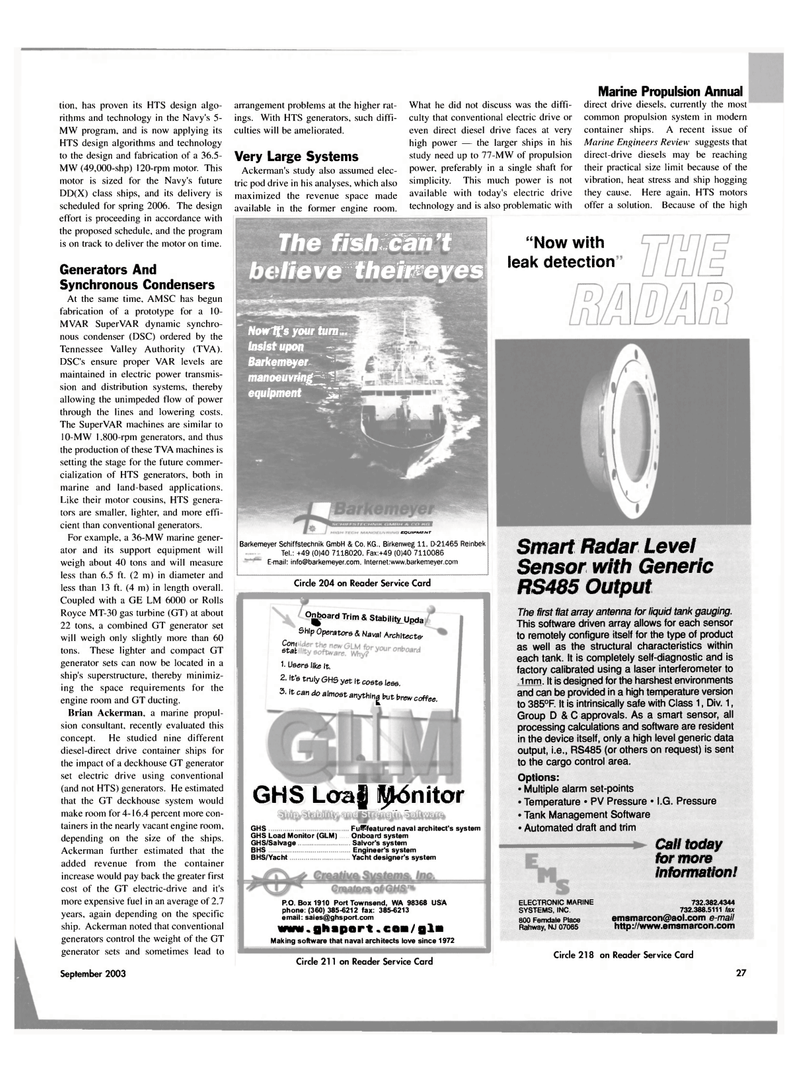
Page 27: of Maritime Reporter Magazine (September 2003)
Read this page in Pdf, Flash or Html5 edition of September 2003 Maritime Reporter Magazine
tion, has proven its HTS design algo- rithms and technology in the Navy's 5-
MW program, and is now applying its
HTS design algorithms and technology to the design and fabrication of a 36.5-
MW (49,000-shp) 120-rpm motor. This motor is sized for the Navy's future
DD(X) class ships, and its delivery is scheduled for spring 2006. The design effort is proceeding in accordance with the proposed schedule, and the program is on track to deliver the motor on time.
Generators And
Synchronous Condensers
At the same time, AMSC has begun fabrication of a prototype for a 10-
MVAR SuperVAR dynamic synchro- nous condenser (DSC) ordered by the
Tennessee Valley Authority (TVA).
DSC's ensure proper VAR levels are maintained in electric power transmis- sion and distribution systems, thereby allowing the unimpeded flow of power through the lines and lowering costs.
The SuperVAR machines are similar to 10-MW 1,800-rpm generators, and thus the production of these TVA machines is setting the stage for the future commer- cialization of HTS generators, both in marine and land-based applications.
Like their motor cousins, HTS genera- tors are smaller, lighter, and more effi- cient than conventional generators.
For example, a 36-MW marine gener- ator and its support equipment will weigh about 40 tons and will measure less than 6.5 ft. (2 m) in diameter and less than 13 ft. (4 m) in length overall.
Coupled with a GE LM 6000 or Rolls
Royce MT-30 gas turbine (GT) at about 22 tons, a combined GT generator set will weigh only slightly more than 60 tons. These lighter and compact GT generator sets can now be located in a ship's superstructure, thereby minimiz- ing the space requirements for the engine room and GT ducting.
Brian Ackerman, a marine propul- sion consultant, recently evaluated this concept. He studied nine different diesel-direct drive container ships for the impact of a deckhouse GT generator set electric drive using conventional (and not HTS) generators. He estimated that the GT deckhouse system would make room for 4-16.4 percent more con- tainers in the nearly vacant engine room, depending on the size of the ships.
Ackerman further estimated that the added revenue from the container increase would pay back the greater first cost of the GT electric-drive and it's more expensive fuel in an average of 2.7 years, again depending on the specific ship. Ackerman noted that conventional generators control the weight of the GT generator sets and sometimes lead to
September 2003 arrangement problems at the higher rat- ings. With HTS generators, such diffi- culties will be ameliorated.
Very Large Systems
Ackerman's study also assumed elec- tric pod drive in his analyses, which also maximized the revenue space made available in the former engine room.
What he did not discuss was the diffi- culty that conventional electric drive or even direct diesel drive faces at very high power — the larger ships in his study need up to 77-MW of propulsion power, preferably in a single shaft for simplicity. This much power is not available with today's electric drive technology and is also problematic with
Marine Propulsion Annual direct drive diesels, currently the most common propulsion system in modern container ships. A recent issue of
Marine Engineers Review suggests that direct-drive diesels may be reaching their practical size limit because of the vibration, heat stress and ship hogging they cause. Here again. HTS motors offer a solution. Because of the high _ mm
The fish can't ilieve their eyes
Nowlfsyour turn
Insist upon —
Barkem&yer ^ manoeuvring 1 equipment '"2Z
EQUIPMENT
Barkemeyer Schiffstechnik GmbH & Co. KG., Birkenweg 11, D-21465 Reinbek
Tel.: +49 (0)40 7118020. Fax:+49 (0)40 7110086
E-mail: [email protected]. lnternet:www.barkemeyer.com
Circle 204 on Reader Service Card
Oj^oard Trim & Stability Upda
Ship Operators & Naval Architects-
SSH 1. Users like it. 2. It's tmlyGHS yet It costs less. 3. It can do almost anything but brew coffee.
GHS Loaf janitor
GHS FufTfeatured naval architect's system
GHS Load Monitor (GLM) Onboard system
GHS/Salvage Salvor's system
BHS Engineer's system
BHS/Yacht Yacht designer's system
P.O. Box 1910 Port Townsend, WA 98368 USA phone: (360) 385-6212 fax: 385-6213 email: [email protected]
WW*.ghsport.com/gin
Making software that naval architects love since 1972
Circle 211 on Reader Service Card "Now with leak detection
Smart Radar Level
Sensor with Generic
RS485 Output
The first flat array antenna for liquid tank gauging.
This software driven array allows for each sensor to remotely configure itself for the type of product as well as the structural characteristics within each tank. It is completely self-diagnostic and is factory calibrated using a laser interferometer to •1mm. It is designed for the harshest environments and can be provided in a high temperature version to 385°F. It is intrinsically safe with Class 1, Div. 1,
Group D & C approvals. As a smart sensor, all processing calculations and software are resident in the device itself, only a high level generic data output, i.e., RS485 (or others on request) is sent to the cargo control area.
Options: • Multiple alarm set-points • Temperature • PV Pressure • I.G. Pressure • Tank Management Software • Automated draft and trim
ELECTRONIC MARINE
SYSTEMS, INC. 800 Ferndale Place
Rahway, NJ 07065
Call today for more information! 732.382.4344 732.388.5111 fax [email protected] e-mail http://www.emsmarcon.com
Circle 218 on Reader Service Card 27

 26
26

 28
28
